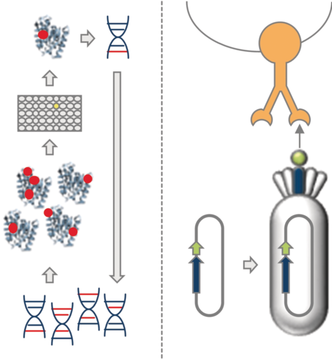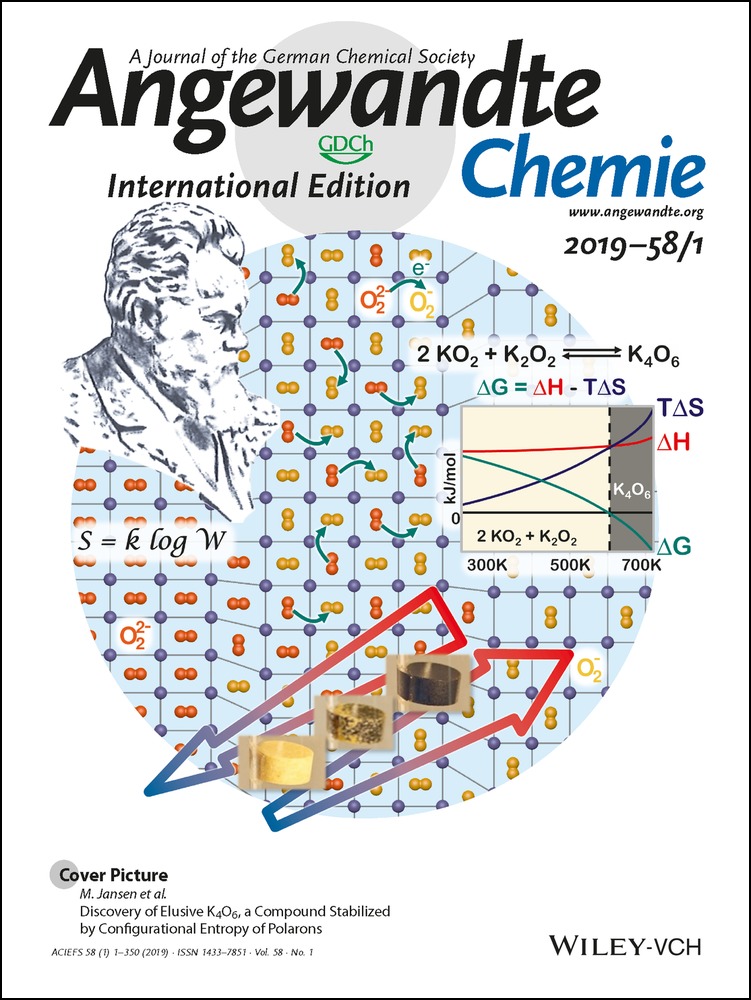Directed Evolution Empowered Redesign of Natural Proteins for the Sustainable Production of Chemicals and Pharmaceuticals
Prof. Dr. Uwe T. Bornscheuer
Biotechnology & Enzyme Catalysis, Institute of Biochemistry, Greifswald University, Felix Hausdorff Strasse 4, 17487 Greifswald, Germany
Search for more papers by this authorProf. Dr. Bernhard Hauer
Institute of Technical Biochemistry, University of Stuttgart, Allmandring 31, 70569 Stuttgart, Germany
Search for more papers by this authorCorresponding Author
Prof. Dr. Karl Erich Jaeger
Institute of Molecular Enzyme Technology, Heinrich Heine University Düsseldorf and Research Center Jülich, Wilhelm Johnen Strasse, 52426 Jülich, Germany
Search for more papers by this authorCorresponding Author
Prof. Dr. Ulrich Schwaneberg
ABBt-Institute of Biotechnology, RWTH Aachen University and DWI Leibniz Institute for, Interactive Materials, Worringer Weg 3, 52074 Aachen, Germany
Search for more papers by this authorProf. Dr. Uwe T. Bornscheuer
Biotechnology & Enzyme Catalysis, Institute of Biochemistry, Greifswald University, Felix Hausdorff Strasse 4, 17487 Greifswald, Germany
Search for more papers by this authorProf. Dr. Bernhard Hauer
Institute of Technical Biochemistry, University of Stuttgart, Allmandring 31, 70569 Stuttgart, Germany
Search for more papers by this authorCorresponding Author
Prof. Dr. Karl Erich Jaeger
Institute of Molecular Enzyme Technology, Heinrich Heine University Düsseldorf and Research Center Jülich, Wilhelm Johnen Strasse, 52426 Jülich, Germany
Search for more papers by this authorCorresponding Author
Prof. Dr. Ulrich Schwaneberg
ABBt-Institute of Biotechnology, RWTH Aachen University and DWI Leibniz Institute for, Interactive Materials, Worringer Weg 3, 52074 Aachen, Germany
Search for more papers by this authorDedicated to the 2018 Nobel Laureates in Chemistry Frances H. Arnold, George P. Smith, and Sir Gregory P. Winter for their pioneering work on the directed evolution of enzymes and the phage display of peptides and antibodies
Graphical Abstract
One half of The Nobel Prize for Chemistry 2018 was awarded to Frances H. Arnold for the directed evolution of enzymes, and the other half jointly to George P. Smith and Sir Gregory P. Winter for the phage display of peptides and antibodies. This Highlight acknowledges the impact of the Nobel Laureates contributions and summarizes the history, state of the art, challenges, and applications of directed evolution and phage display.
Abstract
Directed evolution has advanced into a standard industrial “tool” to tailor naturally occurring proteins for a variety of biotechnological applications, thus enabling product valorization and bringing societal benefits across industrial sectors. Examples are sustainable enzymatic production processes for chemicals, pharmaceuticals, or applications in the food, feed, and laundry industries. In essence, directed evolution has contributed to sustainable industrial processes that fuel the transition from a fossil-based economy to a biobased economy utilizing renewable resources. Phage display technologies represent a comparable breakthrough that allow for the directed evolution of binding proteins by physical coupling between a phenotype and the respective genotype, thus enabling the identification of highly selective antibodies for a broad variety of applications in diagnostics and therapy.
Conflict of interest
The authors declare no conflict of interest.
References
- 1D. R. Mills, R. L. Peterson, S. Spiegelman, Proc. Natl. Acad. Sci. USA 1967, 58, 217–224.
- 2G. F. Joyce, Angew. Chem. Int. Ed. 2007, 46, 6420–6436; Angew. Chem. 2007, 119, 6540–6557.
- 3J. C. Francis, P. E. Hansche, Genetics 1972, 70, 59–73.
- 4B. G. Hall, J. Bacteriol. 1977, 129, 540–543.
- 5M. Eigen, W. Gardiner, Pure Appl. Chem. 1984, 56, 967–978.
- 6
- 6aR. C. Cadwell, G. F. Joyce, Genome Res. 1994, 3, S 136–S140;
- 6bD. L. Robertson, G. F. Joyce, Nature 1990, 344, 467–468;
- 6cA. A. Beaudry, G. F. Joyce, Science 1992, 257, 635–641.
- 7
- 7aT. A. Kunkel, R. R. Meyer, L. A. Loeb, Proc. Natl. Acad. Sci. USA 1979, 76, 6331–6335;
- 7bK. R. Tindall, T. A. Kunkel, Biochemistry 1988, 27, 6008–6013.
- 8
- 8aW. P. Stemmer, Nature 1994, 370, 389–391;
- 8bW. P. Stemmer, Proc. Natl. Acad. Sci. USA 1994, 91, 10747–10751;
- 8cW. P. Stemmer, Bio/Technology 1995, 13, 549–553.
- 9
- 9aT. S. Wong, D. Roccatano, M. Zacharias, U. Schwaneberg, J. Mol. Biol. 2006, 355, 858–871;
- 9bT. S. Wong, K. L. Tee, U. Schwaneberg, Nucleic Acids Res. 2004, 32, e 26;
- 9cA. V. Shivange, J. Marienhagen, H. Mundhada, A. Schenk, U. Schwaneberg, Curr. Opin. Chem. Biol. 2009, 13, 19–25;
- 9dF. Cheng, L. Zhu, U. Schwaneberg, Chem. Commun. 2015, 51, 9760–9772.
- 10K. Q. Chen, F. H. Arnold, Bio/Technology 1991, 11, 1073–1077.
- 11
- 11aZ. X. Shao, F. H. Arnold, Curr. Opin. Struct. Biol. 1991, 6, 513–518;
- 11bF. H. Arnold, Chem. Eng. Sci. 1996, 51, 5091–5102;
- 11cH. M. Zhao, F. H. Arnold, Curr. Opin. Struct. Biol. 1997, 7, 480–485;
- 11dF. H. Arnold, Nat. Biotechnol. 1998, 16, 617–618;
- 11eJ. D. Bloom, M. M. Meyer, P. Meinhold, C. R. Otey, D. MacMillan, F. H. Arnold, Curr. Opin. Struct. Biol. 2005, 15, 447–452;
- 11fC. Schmidt-Dannert, F. H. Arnold, Trends Biotechnol. 1999, 17, 135–136;
- 11gL. You, F. H. Arnold, Prot. Eng. 1994, 9, 77–83;
- 11hT. Bornscheuer, Angew. Chem. Int. Ed. 1998, 37, 3105–3108;
10.1002/(SICI)1521-3773(19981204)37:22<3105::AID-ANIE3105>3.0.CO;2-# CAS PubMed Web of Science® Google ScholarAngew. Chem. 1998, 110, 3285–3288.10.1002/(SICI)1521-3757(19981116)110:22<3285::AID-ANGE3285>3.0.CO;2-2 Web of Science® Google Scholar
- 12
- 12aK. Hiraga, F. H. Arnold, J. Mol. Biol. 2003, 330, 287–296;
- 12bH. M. Zhao, L. Giver, Z. X. Shao, J. A. Affholter, F. H. Arnold, Nat. Biotechnol. 1998, 16, 258–261;
- 12cV. Sieber, C. A. Martinez, F. H. Arnold, Nat. Biotechnol. 2001, 19, 456–460.
- 13J. D. Bloom, S. T. Labthavikul, C. R. Otey, F. H. Arnold, Proc. Natl. Acad. Sci. USA 2006, 103, 5869–5874.
- 14
- 14aH. Renata, Z. J. Wang, F. H. Arnold, Angew. Chem. Int. Ed. 2015, 54, 3351–3367; Angew. Chem. 2015, 127, 3408–3426;
- 14bP. S. Coelho, E. M. Brustad, A. Kannan, F. H. Arnold, Science 2013, 339, 307–310;
- 14cC. K. Prier, R. K. Zhang, A. R. Buller, S. Brinkmann-Chen, F. H. Arnold, Nat. Chem. 2017, 9, 629–634;
- 14dS. B. J. Kan, R. D. Lewis, K. Chen, F. H. Arnold, Science 2016, 354, 1048–1051;
- 14eS. C. Hammer, G. Kubik, E. Watkins, S. Huang, H. Minges, F. H. Arnold, Science 2017, 358, 215–218.
- 15
- 15aM. T. Reetz, A. Zonta, K. Schimossek, K. Liebeton, K.-E. Jaeger, Angew. Chem. Int. Ed. Engl. 1997, 36, 2830–2832; Angew. Chem. 1997, 109, 2961–2963;
- 15bK. Liebeton, A. Zonta, K. Schimossek, M. Nardini, D. Lang, B. W. Dijkstra, M. T. Reetz, K.-E. Jaeger, Chem. Biol. 2000, 7, 709–718.
- 16
- 16aU. T. Bornscheuer, J. Altenbuchner, H. H. Meyer, Biotechnol. Bioeng. 1998, 58, 554–559;
10.1002/(SICI)1097-0290(19980605)58:5<554::AID-BIT12>3.0.CO;2-B CAS PubMed Web of Science® Google Scholar
- 16bM. Schmidt, D. Hasenpusch, M. Kähler, U. Kirchner, K. Wiggenhorn, W. Langel, U. T. Bornscheuer, ChemBioChem 2006, 7, 805-809.
- 17G. P. Smith, Science 1985, 228, 1315–1317.
- 18S. F. Parmley, G. P. Smith, Gene 1988, 73, 305–318.
- 19G. P. Smith, V. A. Petrenko, Chem. Rev. 1997, 97, 391–410.
- 20J. McCafferty, A. D. Griffiths, G. Winter, D. J. Chiswell, Nature 1990, 348, 552–554.
- 21J. D. Marks, H. R. Hoogenboom, T. P. Bonnert, J. McCafferty, A. D. Griffiths, G. Winter, J. Mol. Biol. 1991, 222, 581–597.
- 22G. Winter, A. D. Griffiths, R. E. Hawkins, H. R. Hoogenboom, Annu. Rev. Immunol. 1994, 12, 433–455.
- 23C. K. Savile, J. M. Janey, E. C. Mundorff, J. C. Moore, S. Tam, W. R. Jarvis, J. C. Colbeck, A. Krebber, F. J. Fleitz, J. Brands, P. N. Devine, G. W. Huisman, G. J. Hughes, Science 2010, 329, 305–309.
- 24A. A. Desai, Angew. Chem. Int. Ed. 2011, 50, 1974–1976; Angew. Chem. 2011, 123, 2018–2020.
- 25
- 25aA. J. Ruff, A. Dennig, U. Schwaneberg, FEBS J. 2013, 280, 2961–2978;
- 25bA. Dennig, A. V. Shivange, J. Marienhagen, U. Schwaneberg, PLoS ONE 2011, 6, e 26222.
- 26
- 26aU. Markel, L. Zhu, V. J. Frauenkron-Machedjou, J. Zhao, M. Bocola, D. Davari, K. E. Jaeger, U. Schwaneberg, Catalysts 2017, 7, 142;
- 26bA. Fulton, V. J. Frauenkron-Machedjou, P. Skoczinski, S. Wilhelm, L. Zhu, U. Schwaneberg, K. E. Jaeger, ChemBioChem 2015, 16, 930–936.
- 27
- 27aM. T. Reetz, Angew. Chem. Int. Ed. 2011, 50, 138–174; Angew. Chem. 2011, 123, 144–182;
- 27bsee, for example: C. K. Savile, J. M. Janey, E. C. Mundorff, J. C. Moore, S. Tam, W. R. Jarvis, J. C. Colbeck, A. Krebber, F. J. Fleitz, J. Brands, P. N. Devine, G. W. Huisman, G. J. Hughes, Science 2010, 329, 305–309.
- 28
- 28aR. Kourist, H. Jochens, S. Bartsch, R. Kuipers, S. K. Padhi, M. Gall, D. Böttcher, H.-J. Joosten, U. T. Bornscheuer, ChemBioChem 2010, 11, 1635–1643; original articles:
- 28bH. Jochens, D. Aerts, U. T. Bornscheuer, Protein Eng. Des. Sel. 2010, 23, 903–909;
- 28cH. Jochens, U. T. Bornscheuer, ChemBioChem 2010, 11, 1861–1866;
- 28dH. J. Wijma, R. J. Floor, P. A. Jekel, D. Baker, S. J. Marrink, D. B. Janssen, Protein Eng. Des. Sel. 2014, 27, 49–58;
- 28eH. J. Wijma, M. Furst, D. B. Janssen, Methods Mol. Biol. 2018, 1685, 69–85.
- 29
- 29aU. T. Bornscheuer, G. W. Huisman, R. J. Kazlauskas, S. Lutz, J. C. Moore, K. Robins, Nature 2012, 485, 185–194;
- 29bU. T. Bornscheuer, Philos. Trans. R. Soc. London Ser. A 2018, 376, 20170063.
- 30
- 30aM. T. Reetz, M. Rentzsch, A. Pletsch, M. Maywald, P. Maiwald, J. J.-P. Peyralans, A. Maichele, Y. Fu, N. Jiao, F. Hollmann, R. Mondiere, A. Taglieber, Tetrahedron 2007, 63, 6404–6414;
- 30bM. Jeschek, R. Reuter, T. Heinisch, C. Trindler, J. Klehr, S. Panke, S. T. R. Ward, Nature 2016, 537, 661–665;
- 30cA. R. Grimm, D. F. Sauer, T. Polen, L. L. Zhu, T. Hayashi, J. Okuda, U. Schwaneberg, ACS Catal. 2018, 8, 2611–2614.





